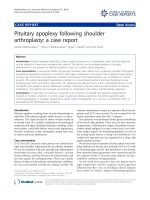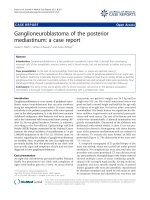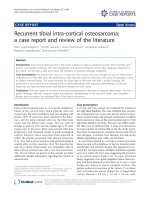Báo cáo y học: "An unusually large myofibroblastoma in a male breast: a case report" docx
Bạn đang xem bản rút gọn của tài liệu. Xem và tải ngay bản đầy đủ của tài liệu tại đây (302.47 KB, 3 trang )
BioMed Central
Page 1 of 3
(page number not for citation purposes)
Journal of Medical Case Reports
Open Access
Case report
An unusually large myofibroblastoma in a male breast: a case report
Abeywardana MS Abeysekara*
1
, HP Priyantha Siriwardana
1
, K F Abbas
1
,
Peter Tanner
2
and Akin A Ojo
1
Address:
1
Department of Surgery, King George Hospital, Barley Lane, Goodmayes, Essex IG3 8YB, UK and
2
Department of Pathology, King George
Hospital, Barley Lane, Goodmayes, Essex IG3 8YB, UK
Email: Abeywardana MS Abeysekara* - ; HP Priyantha Siriwardana - ;
K F Abbas - ; Peter Tanner - ; Akin A Ojo -
* Corresponding author
Abstract
Introduction: Myofibroblastoma of the breast is a rare benign stromal tumour seen
predominantly in men. The gross appearance is that of a well-circumscribed nodule,
characteristically small, seldom exceeding 3 cm. We present a case of an unusually large
myofibroblastoma, which mimicked a malignant breast tumour.
Case presentation: A 65-year-old man presented with a rapid enlargement of the right breast
over 6 weeks. Examination revealed a firm 15 cm hemispherical lump occupying the whole of the
right breast with peau d'orange appearance of the overlying skin and distortion of the nipple. The
clinical and radiological features suggested the possibility of sarcoma of the breast. However, a
guided Tru-Cut biopsy was inconclusive. A mastectomy was performed to remove the tumour,
which weighed more than 2 kg. Histopathology and immunocytochemistry revealed a mixed
classical and collagenised type of myofibroblastoma. The patient is well with no evidence of
recurrence 5 years after the mastectomy.
Conclusion: This unexpected presentation of an unusually large myofibroblastoma in a male
breast is the largest reported to date. Myofibroblastomas can mimic malignant neoplasms and the
clinical significance of this entity lies primarily in its recognition as a distinctive benign neoplasm.
Introduction
Myofibroblastoma is a rare benign tumour of the breast
predominantly seen in men in their sixth to seventh dec-
ades. It was first described by Wargotz et al. in 1987 [1].
Since then, more than 80 cases have been reported and
their gross appearance is that of a well-circumscribed nod-
ule, characteristically small, seldom exceeding 3 cm [2].
They are mesenchymal in origin and may exhibit a wide
spectrum of histological features and a varied cellularity
that can be misinterpreted as a sarcoma. We report a case
of an unexpected presentation of a very large myofibrob-
lastoma of a male breast, which mimicked malignant fea-
tures clinically and radiologically.
Case presentation
A 65-year-old man presented with swelling of his right
breast of 6 weeks duration. The swelling was insidious at
onset but increased rapidly in size. There was no history of
pain or fever associated with the swelling. He was known
to have familial lipomatosis with multiple other swellings
on his body which had been present for several years.
Examination revealed a non-tender, firm 15 cm hemi-
Published: 14 May 2008
Journal of Medical Case Reports 2008, 2:157 doi:10.1186/1752-1947-2-157
Received: 18 August 2007
Accepted: 14 May 2008
This article is available from: />© 2008 Abeysekara et al; licensee BioMed Central Ltd.
This is an Open Access article distributed under the terms of the Creative Commons Attribution License ( />),
which permits unrestricted use, distribution, and reproduction in any medium, provided the original work is properly cited.
Journal of Medical Case Reports 2008, 2:157 />Page 2 of 3
(page number not for citation purposes)
spherical lump occupying the whole of the right breast
with peau d'orange appearance of the overlying skin and
distortion of the nipple. The left breast was normal. There
was no palpable axillary lymphadenopathy. There were
multiple non-tender, soft solid subcutaneous lumps
(lipomas) in the trunk and there was also a large right
sided hydrocele (Fig. 1). Based on the clinical findings of
the breast swelling, it was thought to be a malignant
tumour.
Routine baseline investigations, including chest X-ray,
were within normal limits. Ultrasound scan of the breast
revealed that it was an encapsulated mass containing areas
of decreased echo pattern suggestive of sarcomatous
changes in a lipoma. Magnetic resonance imaging of the
breast swelling detected mixed signals with some areas of
enhancement similar to those seen in soft tissue sarcomas.
Computerised tomography ruled out any pulmonary
metastasis. Mammography showed an enlarged dense
right breast with a well-circumscribed soft tissue mass
occupying almost the whole of the breast leaving a rim of
normal breast tissue. Image guided core biopsy was incon-
clusive and the histological appearances were compatible
with a wide differential diagnosis including fibromatosis,
fasciitis, myofibroblastoma, dermatofibrosarcoma protu-
berance, leiomyoma or peripheral nerve sheath tumour.
The patient underwent a mastectomy of the right breast.
The mastectomy specimen contained a greatly enlarged
male breast of 22 × 16 × 15 cm
3
, weighing 2255 g. Slicing
of the specimen revealed a spherical, soft, degenerated 15
cm mass occupying almost the entire specimen. The cut
surface of the tumour varied in appearance, mostly brown
and soft with a firm white area. The tumour was well cir-
cumscribed and could be 'shelled out' from the surround-
ing breast tissue.
Microscopic sections (Figure 2) revealed a tumour arising
from breast connective tissue with areas which varied in
cellularity. The cellular areas consisted of closely packed
small uniform spindle cells showing relatively little dys-
plasia or pleomorphism and separated by varying
amounts of collagen. Elsewhere myxoid degeneration was
present. The white area noted macroscopically was of low
cellularity, consisting of hyalinised collagen, which
widely separated the tumour cells. The cells in this area
showed greater pleomorphism and atypia. Mitotic figures
were infrequent with no atypical mitoses seen. Although
there was degeneration, no true necrosis was seen.
The tumour was extremely well circumscribed and had no
infiltration to the adjacent breast tissue. The resection
margin was free of tumour. Immunocytochemistry
revealed that it was strongly positive for connective tissue
markers vimentin and CD 34 and smooth muscle cell
marker desmin, and negative for smooth muscle actin,
protein S-100 (a marker for tumours of neural and fat ori-
gin) and epithelial marker MNF 116. Based on the his-
topathology and immunocytochemistry analysis, it was
diagnosed as a myofibroblastoma of the breast. The stains
A representative microscopic picture of a section of the myofibroblastomaFigure 2
A representative microscopic picture of a section of
the myofibroblastoma. This is a high-power view on the
right side of the section.
Photograph illustrating an enlarged right breast, due to myofibroblastoma, with nipple deviation, multiple lipomatosis on the trunk and a large hydroceleFigure 1
Photograph illustrating an enlarged right breast, due
to myofibroblastoma, with nipple deviation, multiple
lipomatosis on the trunk and a large hydrocele.
Publish with BioMed Central and every
scientist can read your work free of charge
"BioMed Central will be the most significant development for
disseminating the results of biomedical research in our lifetime."
Sir Paul Nurse, Cancer Research UK
Your research papers will be:
available free of charge to the entire biomedical community
peer reviewed and published immediately upon acceptance
cited in PubMed and archived on PubMed Central
yours — you keep the copyright
Submit your manuscript here:
/>BioMedcentral
Journal of Medical Case Reports 2008, 2:157 />Page 3 of 3
(page number not for citation purposes)
for oestrogen and androgen receptors were not carried
out. Following mastectomy, the patient made an unevent-
ful recovery and, 5 years later, he remains well with no evi-
dence of recurrence.
Discussion
Soft tissue neoplasms of the breast that are composed of
myofibroblasts have been classified as myofibroblasto-
mas [1]. Myofibroblasts are spindle-shaped or fusiform
mesenchymal cells derived from fibroblasts and are
present in small numbers in all tissues. Proliferation of
myofibroblasts is seen in various conditions including
inflammatory reactions, fibromatosis and some sarcomas
[3]. Ultrastructurally, myofibroblasts have features resem-
bling myo-epithelial cells. Myofibroblasts are distin-
guished from spindle myo-epithelial cells largely on the
basis of their distribution, immunohistochemical staining
and electron microscopic characteristics [4]. Depending
on their phenotypic state, both these types of cells may be
reactive with anti-actin antibodies. Myoepithelial cells are
typically positive for protein S-100 and cytokeratin in
their epithelial phenotype, but myofibroblasts are nega-
tive. Their most common immunoprofile is diffuse
desmin and CD 34 positivity [5]. Histological features and
immunohistocytochemical features in this case were
those of a myofibroblastoma. Microscopically, myofi-
broblastomas can be divided into five sub-types; classical,
epitheloid, collagenised, cellular and infiltrative. In this
case, the myofibroblastoma had features of mixed classi-
cal and collagenised type.
Conclusion
Myofibroblastoma is a rare benign tumour of the breast.
The tumour described in this report is unusual owing to
its presentation, with very rapid enlargement mimicking a
malignant tumour, and its large size, much greater than
any previously reported. Malignant neoplasms, such as
stromal sarcoma, malignant fibrous histiocytoma and
spindle-cell sarcoma, or metaplastic carcinoma should
not be confused with a myofibroblastoma. The clinical
significance of this entity lies primarily in its recognition
as a distinctive benign neoplasm.
Competing interests
The authors declare that they have no competing interests.
Authors' contributions
AMSA is the principal author of the paper, HPPS contrib-
uted in designing the paper and writing the introduction
and discussion, KFA collected the data and contributed to
the case presentation, PT revised and edited the histopa-
thology description and discussion and AAO supervised
the project and undertook the final revision before sub-
mission. All authors read and approved the final manu-
script.
Consent
Written informed consent was obtained from the patient
for publication of this case report and any accompanying
images. A copy of the written consent is available for
review by the Editor-in-Chief of this journal.
Acknowledgements
We acknowledge the medical photography unit of the King George Hospi-
tal.
References
1. Wargotz ES, Weiss SW, Norris HJ: Myofibroblastoma of the
breast. Sixteen cases of a distinctive benign mesenchymal
tumour. Am J Surg Pathol 1987, 11:493-502.
2. Ali S, Teichberg S, Derisi DC, Urmacher C: Giant myofibroblast-
oma of the male breast. A case report. Am J Surg Pathol 1994,
18:1170-1176.
3. Majno G: Story of the myofibroblasts. Am J Surg Pathol 1979,
3:535-542.
4. Ohtani H, Sansano N: Myofibroblasts and myoepithelial cells in
human breast cancer. An ultrastructural study. Virchows Arch
1980, 385:247-261.
5. McMenamin ME, Fletcher CDM: Mammary-type myofibroblast-
oma of soft tissue. Am J Surg Pathol 2001, 25:1022-1029.









